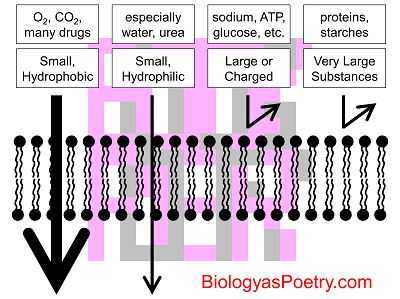∞ generated and posted on 2016.08.24 ∞
Ability to allow the movement of some substances but not of others, particularly across membranes.
Generally permeability is determined by a molecule's size as well as specific chemistry. Lipid bilayers tend to be permeable to small, nonpolar substances while impermeable to large, polar substances.

Figure legend: The selective permeability of a lipid bilayer, one unadorned with transport proteins. Note in particular what can and cannot readily pass across these membranes, with the larger arrow to the left indicating high degrees of permeability and the bent arrows to the right indicating a lack of permeability. Lipid bilayers are selectively permeable especially to small, hydrophobic substances, less so too large and hydrophobic or smaller but polar compounds, and not permeable at all to very large or highly polar and particularly charged substances.
Movement of especially medium-sized polar substances is mediated by proteins that are found embedded within lipid bilayers, that is, by integral membrane proteins known as transport proteins.